As a horseback rider, I've heard those snarky comments about how riding isn't really a workout and how the horse does all the work. But straddling a large, powerful animal with a mind and agenda of its own is a full-body workout that will engage muscles you didn't know existed. There's a reason guys check out female riders, and why women chase around those big buckles and denim backsides. Riders have swag.
Riding horses regularly will test your preconceived notions of fitness and strength. You'll feel uncoordinated while you're in the saddle and sore and tight after you're done. This challenge isn't a quest to make you feel inadequate; there are some serious benefits to gain from going out for a horseback ride through the hills. If you're up to it, saddle up. Here are four fitness benefits to horseback riding!
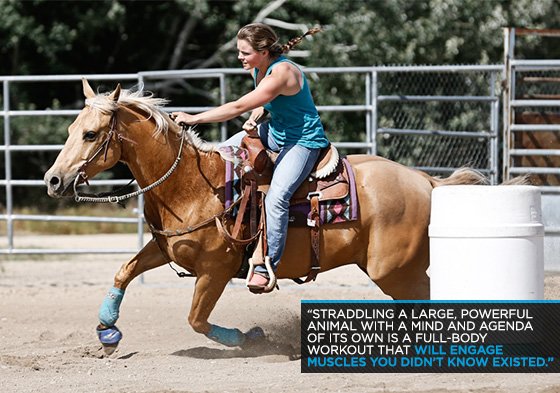
Balance and Stability ///
If you're out water skiing with friends, you don't want to be that guy who face-plants in the water as soon as you say, "Hit it." Stability is essential to transfer energy into effort for any activity, riding included.
When riding on an unstable "surface" like the back of a horse, balance is critical. It sounds pretty easy when the horse is hand-walked by your Uncle Jim, but it can get messy quickly when speed and maneuvers are added. If the horse dives left, you don't dive left also, but stay upright to maintain balance. This may mean transferring your weight to the right to stay stable in the saddle. To make this even more difficult, your legs and arms must be free to cue the horse, and that's impossible if they're latched desperately around the horse's belly and neck.
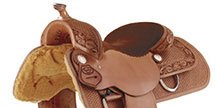
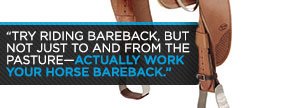

If you're already experienced, try riding bareback, but not just to and from the pasture—actually work your horse bareback. You'll be surprised how poor your balance is sans saddle. If you or the horse isn't up for that, try some in-saddle exercises: While trotting, (this is the bouncy gait slightly faster than a walk), take your feet in and out of the stirrups. Without the stirrups, there is no crutch to keep you in place.
Horseback riding, expert level or no, can improve your balance. This will carry over to other areas of your fitness and life.
Coordination ///
First time riders quickly realize that riding is tougher than it looks. A lot needs to happen simultaneously to get a horse to pick up speed or even walk in a circle without wandering off. This requires coordinating leg pressure, rein pressure, and body position all at once. Try to rub your stomach, pat your head, and skip all at once and let me know how that goes. Similar chaos can happen on a horse.
Ride a couple hours per week to see improved coordination. You'll be more aware of the movements needed to produce a desired result, like making the horse go left like you want it to. After awhile, you will master the simultaneous, but independent movement of your hands, body, and legs. This has great carryover to other sports.
Therapeutic riding programs for the sight-impaired have had a lot of success developing better coordination. Without the aid of a cane or other instrument to guide them, they learn to ride just by feel. This "feel" is the same type of coordination that separates the good athlete from the best. If an athlete has great body awareness, their movements will be more automatic, quick, and effective.
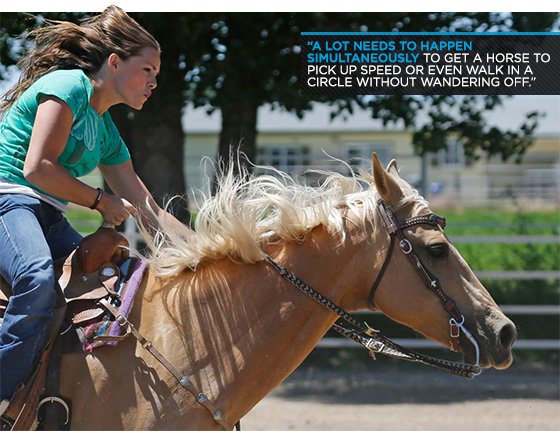
Thighs of Steel ///
Prepare for leg, core, and arm soreness after a day of riding. Unless you prop yourself up against the fence with your horse half-asleep, there is no passive sitting in this sport. There is just no way to ride unless you engage your legs, especially the adductors. A rider has to "squeeze" these muscles to stay put in the saddle. The core must also engage to protect the spine and keep the rider upright.
The quads, hamstrings, and glutes all support the work of the adductors. They are also involved with the forward, backward, and lateral leg movement used to cue the horse. The glutes flex and tighten when you roll your hips down and forward to cue the horse to stop. Keep riding and you'll have a strong enough leg grip to straddle a jet ski or the mechanical bull at your friend's 21st birthday party. You're welcome.
Move into faster gaits and the jarring increases. To compensate and alleviate stress on the spine and hips, you flex. When the horse changes direction you're forced to engage the obliques and transverse abdominals to stay upright. Driving your horse forward will tax the erector spinae and lats. If nothing else, hop on a horse to build a stronger back.
Believe it or not, riding can also help your physique. Muscle tone is created by constant tension, so the flexing and contracting you do while riding will help you look better. Outside of Hoss on Gunsmoke, you don't see many obese cowboys, do you?
Flexibility ///
Even if you can get away without stretching in your normal routine, you can't hope to get on a horse without flexibility. If you have tight hamstrings or glutes, other areas might help compensate to get you through a squat, but there is nothing to help your hips, adductors, or hamstrings when you're awkwardly straddled over a horse's back. Sit in that position long enough and your flexibility will improve. Better flexibility means better range of motion, which equates to improved, heavier lifts. Your calves will also get a good stretch when you ride in the correct position: feet in line with the knee, heels down, back straight. Improved flexibility and reduced tension will lessen the chance of injury when you play a sport or lift.
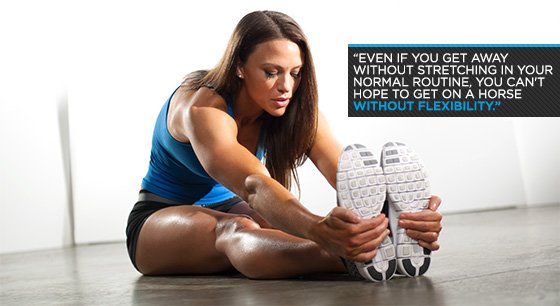
More than anything, riding can help improve weaknesses. Whether the problem is coordination or flexibility, you'll see progression and reap major benefits in sports, hobbies, and daily life. So saddle up!
